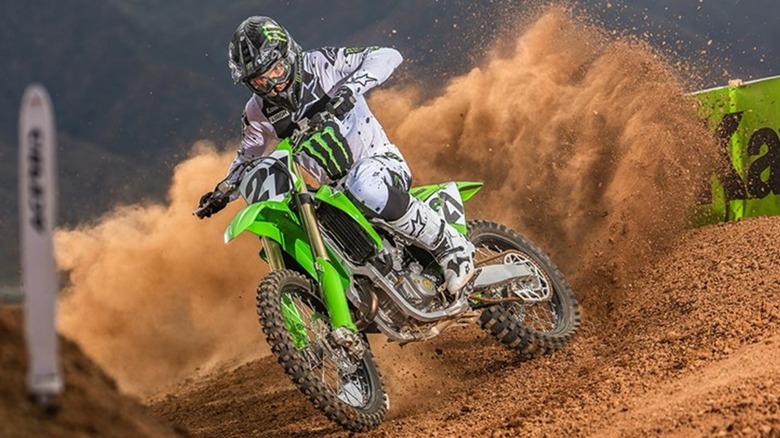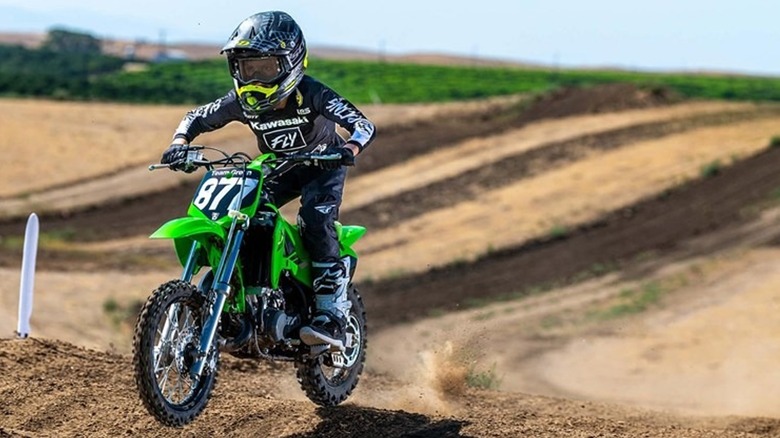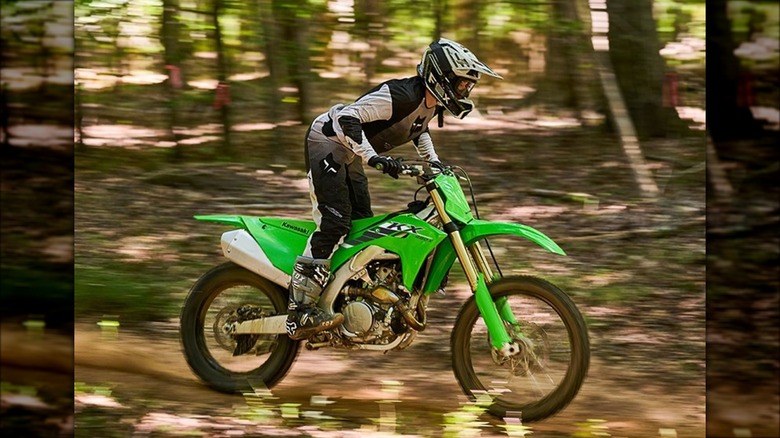What Does KX Mean For Kawasaki Motorcycles?
Kawasaki made its name in motocross in the 1963 Motorcycling Federation of Japan (MFJ) competition, where riders on the company's bikes took the top six spots that year. However, those first Kawasaki motocross race bikes looked different from the ones we see today. First, they had red-painted fuel tanks instead of the now-familiar Lime Green. In addition to the color, those early "Red-tank Kawasaki" motorcycles had short travel front and rear suspensions, air-cooled engines, and very little of the molded trimmings we see today.
To capitalize on that success, Kawasaki formed the Development Team 1 in 1972 to focus on its racing efforts, leading to the creation of "Kawasaki's ultimate motocrossers," shortened to KX. The modern KX precursor saw immediate success with Brad Lackey winning the 1972 American Motorcycle Association (AMA) MX500 championship. Jimmy Weinert continued Kawasaki's motocross success, taking top AMA MX500 honors in 1974 and SX250 in 1976.
Kawasaki released the first production Lime Green two-stroke 125cc 125MX and 250cc 250MX single-cylinder motorcycles to the public in 1973. However, the bikes wouldn't officially use the KX brand until 1975. The continued success of the KX-series earned Kawasaki's place among the best dirt bike brands.
Today, the KX450 is one of the most successful motorcycles in Kawasaki's history. The list of recent AMA Supercross and Motocross (SX/MX) champions includes popular riders like Eli Tomac, James Stewart, and Ryan Villopoto. However, the Kawasaki KX lineup includes dirt bikes aimed at a variety of riders in addition to MX/SX champions.
Kawasaki KX dirt bikes for young riders
Kawasaki's "Youth MX" line of KX dirt bikes includes three models, each offering two-stroke power. These smaller KX motorcycles are racing machines designed to support young racers as they develop foundational skills in the world of MX racing, starting with the KX65.
The Kawasaki KX65 features a liquid-cooled 64cc single-cylinder two-stroke engine and six-speed manual-left-toe-shift transmission and a left-hand-operated clutch lever. The front disc brake is controlled by a lever on the right side of the handlebars and the rear disc brake by a foot-lever in front of the right-side foot peg, just like the bigger KX bikes. The KX65 has a 29.9-inch seat height and multi-position adjustable suspension with over eight inches of travel in the front forks and 9.4-inches of travel from the rear swing-arm.
Stepping up to the Kawasaki KX85, with its liquid-cooled 84cc two-stroke engine, provides a taller 32.7-inch seat height and offers some adjustability with its six-position handlebar mounting system for improved rider comfort. The KX85 also has more suspension travel with 10.8 inches front and rear.
The largest youth-oriented KX, the Kawasaki KX112, features a 112cc liquid-cooled two-stroke engine and a taller 34.3-inch seat height due to its larger wheels and upgraded rear shock compared to the KX85. However, it has the same adjustable handlebars and 10.8-inch suspension travel found on the KX85.
Kawasaki's full-size KX motocross and dirt bikes
Kawasaki's full-size KX lineup includes the KX250, KX450, and limited edition KX450SR. These larger-framed dirt bikes feature liquid-cooled single-cylinder four-stroke engines with dual overhead camshafts. The Kawasaki KX250 engine displaces 249cc whereas the KX450 and KX450SR engines are 449cc, and all three feature a five-speed transmission. Kawasaki lists the seat heights for the KX250, KX450, and KX450SR between 37.6 inches and 37.8 inches.
The KX250 and KX450 provide electronic power modes, traction control, and launch control for better performance on the track. The KX450SR, last updated in 2023, only has launch control. In addition, the newer KX250 and KX450 dirt bikes feature smartphone connectivity via "Rideology the App KX" and a range of adjustments to make them ergonomically easier to ride.
Kawasaki's Rideology App allows engine map editing, including fuel injection and ignition timing settings, for select KX models using the app downloaded on a smartphone. The settings are transferred from the smartphone app to the motorcycle via Bluetooth, eliminating the need for cables or a dedicated ECU tuner.
More than just motocross or supercross
Make no mistake, Kawasaki KX dirt bikes are designed for racing, but not just for motocross or supercross. The company also offers off-road cross-country motorcycle racing models called the KX250X and KX450X.
The Kawasaki KX250X uses components and electronics that are similar to the KX250, but not identical. Differences include the KX250X's 0.5-degree flatter front fork rake angle and smaller rear wheel which deliver a 0.4-inch lower seat height and correspondingly less ground clearance. In addition, the Kawasaki KX450X compares similarly with the KX450 motocross bike with the same 449cc engine displacement and minor differences that result in KX450X seat height and ground clearance lowering less than an inch.
While the KX dirt bikes are powerful machines designed for racing, they can be used for trail riding, although with some modification and consolations. Dirt bikes designed for trail riding have additional armor such as engine protection and hand guards, which can be added to a KX. Other potential modifications to a KX for trail riding include adding a larger fuel tank, softening the suspension settings, and lowering the final drive gearing. Without modification, you'll have to watch for and avoid obstacles that could damage your engine, hands, and handlebar-mounted control levers, add fuel more often, and corral the spirited KX engine and stiff suspension. It's doable but can lead to frustration on tighter trails.


